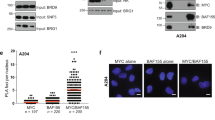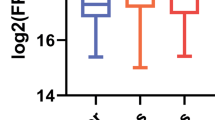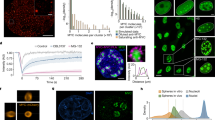Abstract
Although Myc-interacting zinc-finger protein-1 (Miz-1) is known to be a poxvirus and zinc-finger (POZ) transcription factor required for Myc transcriptional repression, additional regulatory function of Miz-1 is less well understood. Using a yeast two-hybrid screen, we identified human alternate reading frame (ARF) protein as a novel interaction partner of Miz-1. The zinc-finger domain of Miz-1 is involved in its binding to ARF. In addition, we found that Miz-1 was able to interact with p53 through its DNA-binding domain, thus to diminish the binding of p53 to its target promoter and inhibit p53-mediated gene transcription. Interestingly, the Miz-1-regulated p53 transcriptional suppression does not require the presence of ARF or Mdm2. Importantly, ARF and p53 were found to competitively bind to Miz-1 in regulating p53-mediated transcription, and this conclusion was verified by both in vitro binding assay and competitive chromatin immunoprecipitation assay using a bona fide p53 endogenous Bax and Puma promoters. Thus, our study reveals that Miz-1 acts as a p53 suppressor by interfering with p53 DNA-binding ability, and ARF is able to counteract the suppression of Miz-1 on p53 by direct binding to Miz-1, suggesting that Miz-1 is a novel mediator in the ARF-p53 pathway.
This is a preview of subscription content, access via your institution
Access options
Subscribe to this journal
Receive 50 print issues and online access
$259.00 per year
only $5.18 per issue
Buy this article
- Purchase on Springer Link
- Instant access to full article PDF
Prices may be subject to local taxes which are calculated during checkout






Similar content being viewed by others
References
Adhikary S, Peukert K, Karsunky H, Beuger V, Lutz W, Elsasser HP et al. (2003). Miz1 is required for early embryonic development during gastrulation. Mol Cell Biol 23: 7648–7657.
Albagli O, Dhordain P, Deweindt C, Lecocq G, Leprince D . (1995). The BTB/POZ domain: a new protein-protein interaction motif common to DNA-and actin-binding proteins. Cell Growth Differ 6: 1193–1198.
Bardwell VJ, Treisman R . (1994). The POZ domain: a conserved protein-protein interaction motif. Genes Dev 8: 1664–1677.
Bothner B, Lewis WS, DiGiammarino EL, Weber JD, Bothner SJ, Kriwacki RW . (2001). Defining the molecular basis of Arf and Hdm2 interactions. J Mol Biol 314: 263–277.
Chen D, Kon N, Li M, Zhang W, Qin J, Gu W . (2005). ARF-BP1/Mule is a critical mediator of the ARF tumor suppressor. Cell 121: 1071–1083.
Collins T, Stone JR, Williams AJ . (2001). All in the family: the BTB/POZ, KRAB, and SCAN domains. Mol Cell Biol 21: 3609–3615.
Giaccia AJ, Kastan MB . (1998). The complexity of p53 modulation: emerging patterns from divergent signals. Genes Dev 12: 2973–2983.
Ha L, Ichikawa T, Anver M, Dickins R, Lowe S, Sharpless NE et al. (2007). ARF functions as a melanoma tumor suppressor by inducing p53-independent senescence. Proc Natl Acad Sci 104: 10968.
Hershko T, Ginsberg D . (2004). Up-regulation of Bcl-2 homology 3 (BH3)-only proteins by E2F1 mediates apoptosis. J Biol Chem 279: 8627–8634.
Honda R, Yasuda H . (1999). Association of p19 ARF with Mdm2 inhibits ubiquitin ligase activity of Mdm2 for tumor suppressor p53. EMBO J 18: 22–27.
Kamijo T, Weber JD, Zambetti G, Zindy F, Roussel MF, Sherr CJ . (1998). Functional and physical interaction of the ARF tumour suppressor with p53 and mdm2. Proc Natl Acad Sci USA 95: 8292–8297.
Kelly KF, Daniel JM . (2006). POZ for effect–POZ-ZF transcription factors in cancer and development. Trends Cell Biol 16: 578–587.
Korgaonkar C, Hagen J, Tompkins V, Frazier AA, Allamargot C, Quelle FW et al. (2005). Nucleophosmin (B23) targets ARF to nucleoli and inhibits its function. Mol Cell Biol 25: 1258–1271.
Lane DP . (1992). Cancer. p53, guardian of the genome. Nature 358: 15–16.
Levine AJ . (1997). p53, the cellular gatekeeper review for growth and division. Cell 88: 323–331.
Lowe SW, Sherr CJ . (2003). Tumor suppression by Ink4a–Arf: progress and puzzles. Curr Opin Gene Dev 13: 77–83.
Midgley CA, Desterro JMP, Saville MK, Howard S, Sparks A, Hay RT et al. (2000). An N-terminal p14 ARF peptide blocks Mdm2-dependent ubiquitination in vitro and can activate p53 in vivo. Oncogene 19: 2312–2323.
Patel JH, McMahon SB . (2007). BCL2 is a downstream effector of MIZ-1 essential for blocking c-MYC-induced apoptosis. J Biol Chem 282: 5–13.
Peukert K, Staller P, Schneider A, Carmichael G, Hanel F, Eilers M . (1997). An alternative pathway for gene regulation by Myc. EMBO J 16: 5672–5686.
Pomerantz J, Schreiber-Agus N, Liegeois NJ, Silverman A, Alland L, Chin L et al. (1998). The Ink4a tumor suppressor gene product, p19Arf, interacts with MDM2 and neutralizes MDM2's inhibition of p53. Cell 92: 713–723.
Quelle DE, Zindy F, Ashmun RA, Sherr CJ . (1995). Alternative reading frames of the INK4a tumor suppressor gene encode two unrelated proteins capable of inducing cell cycle arrest. Cell 83: 993–1000.
Ruas M, Peters G . (1998). The p16INK4a/CDKN2A tumor suppressor and its relatives. BBA-Rev Cancer 1378: 115–177.
Sakurai T, Itoh K, Higashitsuji H, Nagao T, Nonoguchi K, Chiba T et al. (2004). A cleaved form of MAGE-A4 binds to Miz-1 and induces apoptosis in human cells. J Biol Chem 279: 15505–15514.
Salghetti SE, Kim SY, Tansey WP . (1999). Destruction of Myc by ubiquitin-mediated proteolysis: cancer-associated and transforming mutations stabilize Myc. EMBO J 18: 717–726.
Schneider A, Peukert K, Eilers M, Hanel F . (1997). Association of Myc with the zinc-finger protein Miz-1 defines a novel pathway for gene regulation by Myc. Curr Top Microbiol Immunol 224: 137–146.
Seoane J, Pouponnot C, Staller P, Schader M, Eilers M, Massague J . (2001). TGFbeta influences Myc, Miz-1 and Smad to control the CDK inhibitor p15INK4b. Nat Cell Biol 3: 400–408.
Sharpless NE . (2005). INK4a/ARF: a multifunctional tumor suppressor locus. Mutat Res 576: 22–38.
Sharpless NE, DePinho RA . (1999). The INK4A/ARF locus and its two gene products. Curr Opin Genet Dev 9: 22–30.
Sherr CJ . (2001). The INK4a/ARF network in tumour suppression. Nat Rev Mol Cell Biol 2: 731–737.
Staller P, Peukert K, Kiermaier A, Seoane J, Lukas J, Karsunky H et al. (2001). Repression of p15INK4b expression by Myc through association with Miz-1. Nat Cell Biol 3: 392–399.
Suzuki H, Kurita M, Mizumoto K, Moriyama M, Aiso S, Nishimoto I et al. (2005). The ARF tumor suppressor inhibits BCL6-mediated transcriptional repression. Biochem Biophys Res Comm 326: 242–248.
Tago K, Chiocca S, Sherr CJ . (2005). Sumoylation induced by the Arf tumor suppressor: a p53-independent function. Proc Natl Acad Sci USA 102: 7689–7694.
Vogelstein B, Lane D, Levine AJ . (2000). Surfing the p53 network. Nature 408: 307–310.
Vousden KH, Lu X . (2002). Live or let die: the cell's response to p53. Nat Rev Cancer 2: 594–604.
Wanzel M, Kleine-Kohlbrecher D, Herold S, Hock A, Berns K, Park J et al. (2005). Akt and 14-3-3eta regulate Miz1 to control cell-cycle arrest after DNA damage. Nat Cell Biol 7: 30–41.
Weber JD, Jeffers JR, Rehg JE, Randle DH, Lozano G, Roussel MF et al. (2000). p53-independent functions of the p19ARF tumor suppressor. Genes Dev 14: 2358–2365.
Wu S, Cetinkaya C, Munoz-Alonso MJ, von der Lehr N, Bahram F, Beuger V et al. (2003). Myc represses differentiation-induced p21CIP1 expression via Miz-1-dependent interaction with the p21 core promoter. Oncogene 22: 351–360.
Zhao N, Wang J, Cui Y, Guo L, Lu SH . (2004). Induction of G1 cell cycle arrest and P15INK4b expression by ECRG1 through interaction with Miz-1. J Cell Biochem 92: 65–76.
Ziegelbauer J, Wei J, Tjian R . (2004). Myc-interacting protein 1 target gene profile: a link to microtubules, extracellular signal-regulated kinase, and cell growth. Proc Natl Acad Sci USA 101: 458–463.
Acknowledgements
We thank Dr Nickie Chan for English checking and Dr Ratna B Ray for the plasmid pGL3-13-p53-Luc. This study was supported by grants from the National Natural Science Foundation of China (30530200, 30728003 and 30871290), the Ministry of Science and Technology of China (2006CB933300, 2006CB0N1402, and 2006CB910300) and the Chinese Academy of Sciences (KSCX1-YW-R-57).
Author information
Authors and Affiliations
Corresponding author
Rights and permissions
About this article
Cite this article
Miao, L., Song, Z., Jin, L. et al. ARF antagonizes the ability of Miz-1 to inhibit p53-mediated transactivation. Oncogene 29, 711–722 (2010). https://doi.org/10.1038/onc.2009.372
Received:
Revised:
Accepted:
Published:
Issue Date:
DOI: https://doi.org/10.1038/onc.2009.372
Keywords
This article is cited by
-
iASPP induces EMT and cisplatin resistance in human cervical cancer through miR-20a-FBXL5/BTG3 signaling
Journal of Experimental & Clinical Cancer Research (2017)
-
miRNA regulation is important for DNA damage repair and recognition in malignant pleural mesothelioma
Virchows Archiv (2017)
-
Suppression of iASPP-dependent aggressiveness in cervical cancer through reversal of methylation silencing of microRNA-124
Scientific Reports (2016)
-
Decreased MIZ1 Expression in Severe Experimental Acute Pancreatitis: A Rat Study
Digestive Diseases and Sciences (2016)
-
MDM2 is an important prognostic and predictive factor for platin–pemetrexed therapy in malignant pleural mesotheliomas and deregulation of P14/ARF (encoded by CDKN2A) seems to contribute to an MDM2-driven inactivation of P53
British Journal of Cancer (2015)



